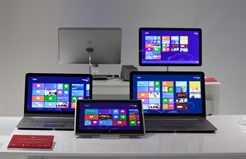Microsoft CFO Klein: We're ready for devices of all sizes

For years, "write once, run anywhere" has been the dream of many developers and -- whether or not they knew it -- Windows customers who have wanted to share the same apps across different screens.

Microsoft is getting closer to making dream a reality, Chief Financial Officer (CFO) Peter Klein told attendees of the Goldman Sachs Technology & Internet Conference during a Q&A session on February 13.
Klein was asked about Microsoft's plans to address the tablet and phone market with device form factors ranging from 4 inches to 13 inches and beyond.
"We've done a lot of the hard work in the developer platform," Klein said. "We are well set up to respond to demand as we see it" with different-sized form factors, he said.
Klein's response echoed that of Windows CFO Tami Reller, with whom I spoke recently. Reller also made a point of saying that Windows 8 was designed from the outset to run on smaller and bigger screens at different resolutions, and that it's the underlying app platform/app model that enables this.
This new "we'll see what customers want" in terms of screen size is a markedly different message from Microsoft officials than just a year ago, when Microsoft execs pooh-poohed the advantage of smaller screen sizes for Windows devices that could act as both creation and consumption platforms.
Klein did note that it's not operating systems that matter in the end; it's more the common experiences -- apps and services like Xbox Live, Skype, SmartGlass -- that are what really matter to consumers. That said, it's the evolving underlying application programming interfaces (APIs) that will be what enables developers of these apps and services to get closer cross-platform nirvana.
"We are getting closer and closer every day to write once and run anywhere," Klein said.
Microsoft is forging ahead on attempts solve this problem, as a recent job post (which has since been filled and removed from the company's Careers site) made plain. That post noted that Microsoft is attempting to unify further its Windows Phone and Windows development platforms and APIs.
"We are looking for a highly motivated and technically strong SDET (software development engineer in test) to help our team bring together the Windows Store and Phone development platforms," the job post continued. To make this happen, Microsoft is "bring(ing) much of the WinRT API (application programming interface) surface and the .NET Windows Store profile to the Phone," according to the job post. The ultimate goal: "(T)he code you write for Windows Store apps would just work on the Windows Phone and vice versa."
The "Blue" Windows and Windows Phone updates which Microsoft's Windows client and Phone teams are building are expected to include new APIs and core-level changes that will help increase commonalities between the two platforms, according to my contacts.
In response to questions outside the realm of multi-size-screen support, Klein had nothing new to say about when/whether Microsoft will make Office available on iOS.
When asked about learnings Microsoft has gleaned from the Surface launch -- starting back in October when the company made available the Surface RT -- Klein said the company came to understand that users need to touch, see and play with the Surface. Building awareness alone isn't enough, he acknowledged. Klein also said updates Microsoft is making to the Surfaces based on user feedback are going to go back into the Windows 8 and Windows RT operating systems that will benefit the entire ecosystem.